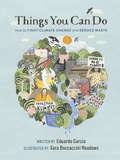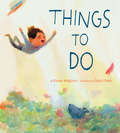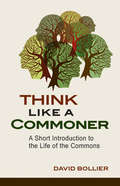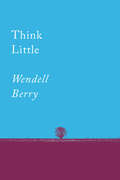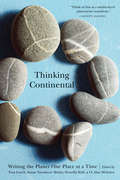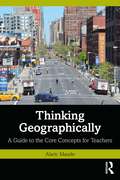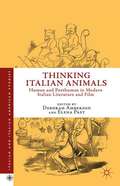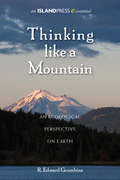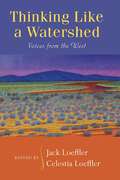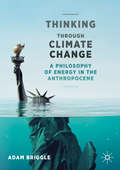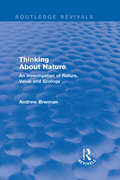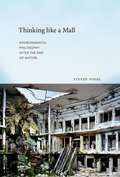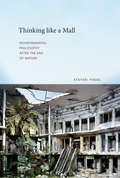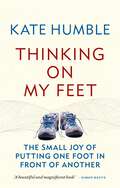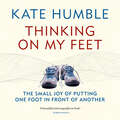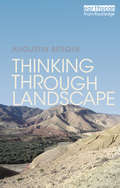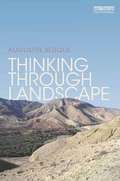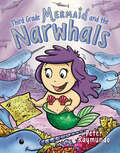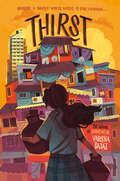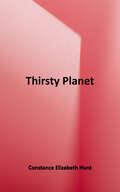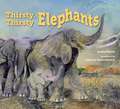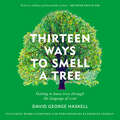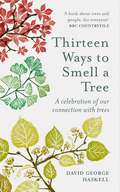- Table View
- List View
Things You Can Do: How to Fight Climate Change and Reduce Waste
by Eduardo GarciaLearn what you can do right now to reduce your carbon footprint with this inspiring, accessible, stunningly illustrated book based on Eduardo Garcia&’s popular New York Times column. &“This beautiful and practical book on the climate crisis is for people of all ages, packed with wonderful pictures, powerful stats, and sound advice.&”—Mike Berners-Lee, author of There Is No Planet BAward-winning climate journalist Eduardo Garcia offers a deeply researched and user-friendly guide to the things we can do every day to fight climate change. Based on his popular New York Times column &“One Thing You Can Do,&” this fully illustrated book proposes simple solutions for an overwhelming problem. No lectures here—just accessible and inspiring ideas to slash emissions and waste in our daily lives, with over 350 explanatory illustrations by talented painter Sara Boccaccini Meadows.In each chapter, Garcia digs into the issue, explaining how everyday choices lead to carbon emissions, then delivers a wealth of &“Things You Can Do&” to make a positive impact, such as:• Eat a climate-friendly diet• Reduce food waste• Cool your home without an air conditioner• Save energy at home• Adopt zero-waste practices• Increase the fuel efficiency of your car• Buy low-carbon pet food• Hack your toilet to save water• Slash the carbon footprint of your online shoppingDelivering a decisive hit of knowledge with every turn of the page, Things You Can Do is the book for people who want to know more—and do more—to save the planet.
Things to Do
by Elaine MagliaroWith playful prose and vivid art, Things to Do brings to life the small moments and secret joys of a child's day. There are wonders everywhere. In the sky and on the ground—blooming in a flower bed, dangling from a silken thread, buzzing through the summer air—waiting ...waiting to be found. In this thoughtful and ingenious collection of poems, Elaine Magliaro, an elementary school teacher for more than three decades and a school librarian for three years, and illustrator Catia Chien provide a luminous glimpse of the ordinary wonders all around us. Plus, this is the fixed format version, which looks almost identical to the print edition.
Think Like a Commoner
by David BollierThe biggest "tragedy of the commons" is the misconception that commons are failures--relics from another era rendered unnecessary by the market and state. Think Like a Commoner dispels such prejudices by explaining the rich history and promising future of the commons--an ageless paradigm of cooperation and fairness that is re-making our world.With graceful prose and dozens of fascinating stories, David Bollier describes the quiet revolution that is pioneering practical forms of self-governance and production controlled by people themselves. Think Like a Commoner explains how the commons: Is an exploding field of DIY innovation ranging from Wikipedia and seed-sharing to community forests, collaborative consumption, and beyond Challenges the standard narrative of market economics by explaining how cooperation generates significant value and human fulfillment Provides a framework of law and social action that can help us move beyond the pathologies of neoliberal capitalismWe have a choice: ignore the commons and suffer the ongoing private plunder of our common wealth, or Think Like a Commoner and learn how to rebuild our society and reclaim our shared inheritance. This accessible, comprehensive introduction to the commons will surprise and enlighten you, and provoke you to action.David Bollier is an author, activist, blogger, and independent scholar. He is the author of six books on different aspects of the commons, including Green Governance, The Wealth of the Commons, and Viral Spiral, and is a frequent speaker at conferences, colleges and universities, and policy workshops.
Think Little: Essays (Counterpoints #1)
by Wendell BerryFirst published in 1972, “Think Little” is cultural critic and agrarian Wendell Berry at his best: prescient about the dire environmental consequences of our mentality of greed and exploitation, yet hopeful that we will recognize war and oppression and pollution not as separate issues, but aspects of the same. “Think Little” is presented here alongside one of Berry’s most popular and personal essays, “A Native Hill.” This gentle essay of recollection is told alongside a poetic lesson in geography, as Berry explains at length and in detail, that what he stands for is what he stands on.Each palm–size book in the Counterpoints series is meant to stay with you, whether safely in your pocket or long after you turn the last page. From short stories to essays to poems, these little books celebrate our most–beloved writers, whose work encapsulates the spirit of Counterpoint Press: cutting–edge, wide–ranging, and independent.
Thinking Continental: Writing the Planet One Place at a Time
by Tom Lynch Susan Naramore Maher O. Alan Weltzien Drucilla WallIn response to the growing scale and complexity of environmental threats, this volume collects articles, essays, personal narratives, and poems by more than forty authors in conversation about “thinking continental”—connecting local and personal landscapes to universal systems and processes—to articulate the concept of a global or planetary citizenship.Reckoning with the larger matrix of biome, region, continent, hemisphere, ocean, and planet has become necessary as environmental challenges require the insights not only of scientists but also of poets, humanists, and social scientists. Thinking Continental braids together abstract approaches with strands of more-personal narrative and poetry, showing how our imaginations can encompass the planetary while also being true to our own concrete life experiences in the here and now.
Thinking Geographically: A Guide to the Core Concepts for Teachers
by Alaric MaudeThis book explains how the concepts of geography can teach young people to think geographically, deeply and ethically. Thinking Geographically demonstrates how the concepts of place, space, environment and interconnection teach students new ways of perceiving and understanding the world, the concepts of scale and time teach them ways of analysing the world, while the concepts of sustainability and wellbeing show them how to evaluate and reflect on what they observe, and all eight concepts develop their higher order and critical thinking. To further support teachers, this book includes a chapter on how to teach for conceptual understanding, as well as two chapters that illustrate the application of geographical thinking to an understanding of the effects of land cover change and the problem of regional inequality. Rich with practical examples, this book is an essential resource for geography teachers, whether already teaching or studying to become one, and for those who teach therm.
Thinking Italian Animals
by Deborah Amberson Elena PastSituated on the cutting edge of scholarship in a variety of fields, this bracing volume draws together essays on Italian writers and filmmakers whose work engages with nonhuman animal subjectivity. Analyzing works from unification to the present, they address three major strands of current philosophical thought: the perceived borders between man and nonhuman animals, historical and fictional crises facing humanity, and human entanglement with the nonhuman and material world. These essays are driven by philosophical, theoretical, and ethical questions that interrogate Italian cultural production in provocative new ways, and their analysis has implications not simply for Italianists, but for a range of scholars doing work within cross-disciplinary fields such as animal studies, ecocriticism, and posthuman philosophy.
Thinking Like a Mountain: An Ecological Perspective on Earth (Island Press E-ssentials)
by R. Edward GrumbineIn Thinking Like a Mountain, we have excerpted a clear and inviting introduction to the science of conservation biology from Ed Grumbine's previous book, Ghost Bears. Grumbine offers a succinct and evocative description of why we should all care about biodiversity, protected lands, connectivity, and extinction rates, and the advantages to be gained by attempting to 'think like a mountain', as so eloquently phrased by Aldo Leopold.
Thinking Like a Watershed: Voices from the West
by Jack Loeffler Celestia LoefflerThinking Like a Watershed points our understanding of our relationship to the land in new directions. It is shaped by the bioregional visions of the great explorer John Wesley Powell, who articulated the notion that the arid American West should be seen as a mosaic of watersheds, and the pioneering ecologist Aldo Leopold, who put forward the concept of bringing conscience to bear within the realm of &“the land ethic.&”Produced in conjunction with the documentary radio series entitled Watersheds as Commons, this book comprises essays and interviews from a diverse group of southwesterners including members of Tewa, Tohono O&’odham, Hopi, Navajo, Hispano, and Anglo cultures. Their varied cultural perspectives are shaped by consciousness and resilience through having successfully endured the aridity and harshness of southwestern environments over time.
Thinking Through Climate Change: A Philosophy of Energy in the Anthropocene (Palgrave Studies in the Future of Humanity and its Successors)
by Adam BriggleIn this creative exploration of climate change and the big questions confronting our high-energy civilization, Adam Briggle connects the history of philosophy with current events to shed light on the Anthropocene (the age of humanity). Briggle offers a framework to help us understand the many perspectives and policies on climate change. He does so through the idea that energy is a paradox: changing sameness. From this perennial philosophical mystery, he argues that a high-energy civilization is bound to create more and more paradoxes. These paradoxes run like fissures through our orthodox picture of energy as the capacity to do work and control fate. Climate change is the accumulation of these fissures and the question is whether we can sustain technoscientific control and economic growth. It may be that our world is about change radically, imploring us to start thinking heterodox thoughts.
Thinking about Nature: An Investigation of Nature, Value and Ecology (Routledge Revivals)
by Andrew BrennanEcology – unlike astronomy, physics, or chemistry – is a science with an associated political and ethical movement: the Green Movement. As a result, the ecological position is often accompanied by appeals to holism, and by a mystical quasi-religious conception of the ecosystem. In this title, first published in 1988, Andrew Brennan argues that we can reduce much of the mysticism surrounding ecological discussions by placing them within a larger context, and illustrating that our individual interests are bound with larger, community interests. Using an interdisciplinary approach, which bridges the gap between the sciences, philosophy, and ethics, this is an accessible title, which will be of particular value to students with an interest in the philosophy of environmental science and ethics.
Thinking like a Mall
by Steven VogelEnvironmentalism, in theory and practice, is concerned with protecting nature. But if we have now reached "the end of nature," as Bill McKibben and other environmental thinkers have declared, what is there left to protect? In Thinking like a Mall, Steven Vogel argues that environmental thinking would be better off if it dropped the concept of "nature" altogether and spoke instead of the "environment" -- that is, the world that actually surrounds us, which is always a built world, the only one that we inhabit. We need to think not so much like a mountain (as Aldo Leopold urged) as like a mall. Shopping malls, too, are part of the environment and deserve as much serious consideration from environmental thinkers as do mountains. Vogel argues provocatively that environmental philosophy, in its ethics, should no longer draw a distinction between the natural and the artificial and, in its politics, should abandon the idea that something beyond human practices (such as "nature") can serve as a standard determining what those practices ought to be. The appeal to nature distinct from the built environment, he contends, may be not merely unhelpful to environmental thinking but in itself harmful to that thinking. The question for environmental philosophy is not "how can we save nature?" but rather "what environment should we inhabit, and what practices should we engage in to help build it?"
Thinking like a Mall: Environmental Philosophy after the End of Nature (The\mit Press Ser.)
by Steven VogelA provocative argument that environmental thinking would be better off if it dropped the concept of “nature” altogether and spoke instead of the built environment.Environmentalism, in theory and practice, is concerned with protecting nature. But if we have now reached “the end of nature,” as Bill McKibben and other environmental thinkers have declared, what is there left to protect? In Thinking like a Mall, Steven Vogel argues that environmental thinking would be better off if it dropped the concept of “nature” altogether and spoke instead of the “environment”—that is, the world that actually surrounds us, which is always a built world, the only one that we inhabit. We need to think not so much like a mountain (as Aldo Leopold urged) as like a mall. Shopping malls, too, are part of the environment and deserve as much serious consideration from environmental thinkers as do mountains. Vogel argues provocatively that environmental philosophy, in its ethics, should no longer draw a distinction between the natural and the artificial and, in its politics, should abandon the idea that something beyond human practices (such as “nature”) can serve as a standard determining what those practices ought to be. The appeal to nature distinct from the built environment, he contends, may be not merely unhelpful to environmental thinking but in itself harmful to that thinking. The question for environmental philosophy is not “how can we save nature?” but rather “what environment should we inhabit, and what practices should we engage in to help build it?”
Thinking on My Feet: The small joy of putting one foot in front of another
by Kate Humble'An enticing read that makes every walk Humble describes an adventure' - Ranulph Fiennes'A beautiful and magnificent book. A paean to a simple act. I defy you to read this book and not be inspired to walk, march or hike - and as a result live a better life more connected with nature and the world around you.' - Simon Reeve'A lovely book, fast-flowing yet at every turn giving the reader pause for thought. Kate Humble makes a delightful companion, her words full of sunshine and the raw pleasure she radiates as she encounters life in its many unexpected forms.' - Benedict Allen'I've discovered that going for a daily walk has become as essential to me feeling good for the rest of the day as that first cup of tea. But I would argue that all I am doing is responding to a natural need we all have. Humans have always been migrants, the physiological urge to be nomadic is deep-rooted in all of us and perhaps because of that our brains are stimulated by walking. I solve all sorts of problems, formulate ideas, work things out to that gentle rhythm of self-propelled movement.' - Kate HumbleThinking on My Feet tells the story of Kate's walking year - shining a light on the benefits of this simple activity. Kate's inspiring narrative not only records her walks (and runs) throughout a single year, but also charts her feelings and impressions throughout - capturing the perspectives that only a journey on foot allows - and shares the outcomes: a problem solved, a mood lifted, an idea or opportunity borne. As she explores the reasons why we walk, whether for creative energy, challenge and pleasure, or therapeutic benefits, Kate's reflections and insights will encourage, motivate and spur readers into action.Also featured are Kate's walks with others who have discovered the magical, soothing effect of putting one foot in front of the other - the artist who walks to find inspiration for his next painting; the man who takes people battling with addiction to climb mountains; the woman who walked every footpath in Wales (3,700 miles) when she discovered she had cancer.This book will inspire you to change your perspective by applying walking to your daily endeavours.
Thinking on My Feet: The small joy of putting one foot in front of another
by Kate Humble'I've discovered that going for a daily walk has become as essential to me feeling good for the rest of the day as that first cup of tea. But I would argue that all I am doing is responding to a natural need we all have. Humans have always been migrants, the physiological urge to be nomadic is deep-rooted in all of us and perhaps because of that our brains are stimulated by walking. I solve all sorts of problems, formulate ideas, work things out to that gentle rhythm of self-propelled movement.' - Kate HumbleThinking on My Feet is an inspiring journal of walks divided into seasonal sections. Discover the joys and benefits of walking, encounters with the natural and urban world, with the familiar and strange, with animals, people and events. Kate charts her feelings and impressions throughout, capturing the perspectives that only a journey on foot allows. Find out what makes you curious, what makes something memorable.Also included are Kate's walks with other people who have discovered the magical, soothing effect of putting one foot infront of the other - the artist who walks to find inspiration for his next painting; the man who takes people battling with addiction to climb mountains; the woman who walked every footpath in Wales (3,700 miles) when she discovered she had cancer. This book will inspire you to change your perspective by applying walking to your daily endeavours.(p) 2018 Octopus Publishing Group
Thinking on My Feet: The small joy of putting one foot in front of another (Kate Humble)
by Kate Humble** SHORTLISTED FOR THE WAINWRIGHT PRIZE**** SHORTLISTED FOR THE EDWARD STANFORD TRAVEL WRITING AWARD - TRAVEL MEMOIR OF THE YEAR **A lovely, civilised and transporting read, that should have all of us stepping out to meet the world with fresh eyes.' - Hugh Fearnley-Whittingstall'An enticing read that makes every walk Humble describes an adventure' - Ranulph Fiennes'A beautiful and magnificent book. A paean to a simple act. I defy you to read this book and not be inspired to walk, march or hike - and as a result live a better life more connected with nature and the world around you.' - Simon Reeve'A lovely book, fast-flowing yet at every turn giving the reader pause for thought. Kate Humble makes a delightful companion, her words full of sunshine and the raw pleasure she radiates as she encounters life in its many unexpected forms.' - Benedict Allen'I've discovered that going for a daily walk has become as essential to me feeling good for the rest of the day as that first cup of tea. But I would argue that all I am doing is responding to a natural need we all have. Humans have always been migrants, the physiological urge to be nomadic is deep-rooted in all of us and perhaps because of that our brains are stimulated by walking. I solve all sorts of problems, formulate ideas, work things out to that gentle rhythm of self-propelled movement.' - Kate HumbleThinking on My Feet tells the story of Kate's walking year - shining a light on the benefits of this simple activity. Kate's inspiring narrative not only records her walks (and runs) throughout a single year, but also charts her feelings and impressions throughout - capturing the perspectives that only a journey on foot allows - and shares the outcomes: a problem solved, a mood lifted, an idea or opportunity borne. As she explores the reasons why we walk, whether for creative energy, challenge and pleasure, or therapeutic benefits, Kate's reflections and insights will encourage, motivate and spur readers into action.Also featured are Kate's walks with others who have discovered the magical, soothing effect of putting one foot in front of the other - the artist who walks to find inspiration for his next painting; the man who takes people battling with addiction to climb mountains; the woman who walked every footpath in Wales (3,700 miles) when she discovered she had cancer.This book will inspire you to change your perspective by applying walking to your daily endeavours.*PRAISE FOR THINKING ON MY FEET *'A diary of sorts, charting a year of wonderful walks through the sun, wind and rain...each entry builds an image of her life in the great outdoors...it sounds idyllic to say the least.' - Sunday Express, S Magazine'These are 365 days of inspiration to get out and, sometimes literally, smell the flowers.' - Wanderlust Magazine'Humble's book about going for a walk can inspire absolutely anyone to make a change. Because all you have to do is step outside the front door.' - Waitrose Weekend'Witty, enlightening and often startlingly profound' - Country Walking Magazine
Thinking through Landscape
by Augustin BerqueOur attitude to nature has changed over time. This book explores the historical, literary and philosophical origins of the changes in our attitude to nature that allowed environmental catastrophes to happen.The book presents a philosophical reflection on human societies’ attitude to the environment, informed by the history of the concept of landscape and the role played by the concept of nature in the human imagination. It features a wealth of examples from around the world to help understand the contemporary environmental crisis in the context of both the built and natural environment. Berque locates the start of this change in human labour and urban elites being cut off from nature. Nature became an imaginary construct masking our real interaction with the natural world. He argues that this gave rise to a theoretical and literary appreciation of landscape at the expense of an effective practical engagement with nature. This mindset is a general feature of the world's civilizations, manifested in similar ways in different cultures across Europe, China, North Africa and Australia. Yet this approach did not have disastrous consequences until the advent of western industrialization.As a phenomenological hermeneutics of human societies’ environmental relation to nature, the book draws on Heideggerian ontology and Veblen’s sociology. It provides a powerful distinction between two attitudes to landscape: the tacit knowledge of earlier peoples engaged in creating the landscape through their work - “landscaping thought”- and the explicit theoretical and aesthetic attitudes of modern city dwellers who love nature while belonging to a civilization that destroys the landscape - “landscape thinking”. This book gives a critical survey of landscape thought and theory for students, researchers and anyone interested in human societies’ relation to nature in the fields of landscape studies, environmental philosophy, cultural geography and environmental history.
Thinking through Landscape
by Augustin BerqueOur attitude to nature has changed over time. This book explores the historical, literary and philosophical origins of the changes in our attitude to nature that allowed environmental catastrophes to happen. It presents a philosophical reflection on human societies’ attitude to the environment, informed by the history of the concept of landscape and the role played by the concept of nature in the human imagination and features a wealth of examples from around the world to help understand the contemporary environmental crisis in the context of both the built and natural environment. Thinking Through Landscape locates the start of this change in human labour and urban elites being cut off from nature. Nature became an imaginary construct masking our real interaction with the natural world. The book argues that this gave rise to a theoretical and literary appreciation of landscape at the expense of an effective practical engagement with nature. It draws on Heideggerian ontology and Veblen’s sociology, providing a powerful distinction between two attitudes to landscape: the tacit knowledge of earlier peoples engaged in creating the landscape through their work - "landscaping thought"- and the explicit theoretical and aesthetic attitudes of modern city dwellers who love nature while belonging to a civilization that destroys the landscape - "landscape thinking". This book gives a critical survey of landscape thought and theory for students, researchers and anyone interested in human societies’ relation to nature in the fields of landscape studies, environmental philosophy, cultural geography and environmental history.
Third Grade Mermaid and the Narwhals
by Peter RaymundoIn the second book in the heavily illustrated chapter book series, Cora the irrepressible third grade mermaid and friends are looking for narwhals!When Cora reads a short story she wrote about a narwhal in her English class, Vivian Shimmermore mocks her and says that everyone knows that narwhals are fake. Suddenly Cora and her friends are embarking on an exciting quest to find these not-so-mythical creatures and prove Vivian wrong. And then, Cora finds out that their adventures could actually win her the top prize in the Ocean Writes contest... if she can manage to write the whole story down before the deadline!
Thirst
by Varsha BajajA New York Times BestsellerThe riveting story of a heroic girl who fights for her belief that water should be for everyone.Minni lives in the poorest part of Mumbai, where access to water is limited to a few hours a day and the communal taps have long lines. Lately, though, even that access is threatened by severe water shortages and thieves who are stealing this precious commodity—an act that Minni accidentally witnesses one night. Meanwhile, in the high-rise building where she just started to work, she discovers that water streams out of every faucet and there&’s even a rooftop swimming pool. What Minni also discovers there is one of the water mafia bosses. Now she must decide whether to expose him and risk her job and maybe her life. How did something as simple as access to water get so complicated?
Thirsty Planet: Strategies for Sustainable Water Management
by Constance Elizabeth HuntBy the year 2025 nearly 2 billion people will live in regions experiencing absolute water scarcity. In the face of this emerging crisis, how should the planet's water be used and managed? Current international policy sees nature competing with human uses of water. Hunt takes issue with this perspective. She suggests that nature is the source of water and only by making the conservation of nature an absolute priority will we have the water we need for human use in future. It is essential , therefore, to manage water in ways that maintain the water cycle and the ecosystems that support it. This book looks at the complexity of the problem. It provides a wide array of ideas, information, case studies and ecological knowledge - often from remote corners of the developing world -- that could provide an alternative vision for water use and management at this critical time. Essential and compelling reading for students on courses related to water resource management and development; water managers and decision makers, and non-specialists with an interest in global water issues.
Thirsty, Thirsty Elephants
by Sandra MarkleElephants never forget During a drought in Tanzania, Grandma Elephant is in search of water for her herd. Little Calf follows along and mimics her grandmother at each stop on their journey. When Grandma leads them to a watering hole she recalls from years before, the elephants are overjoyed and Little Calf splashes about with her tender leader. Grandma's persistence and powerful memory is something Little Calf will never forget. Based on true events. Sandra Markle&’s acclaimed nonfiction writing takes on a more lyrical style alongside Fabricio VandenBroeck&’s gorgeous illustrations making this story of animal behavior accessible for younger readers. Back matter includes further information about the phenomenon of a herd of elephants that survived a drought, as well as fascinating elephant facts.
Thirteen Ways to Smell a Tree: Getting to know trees through the language of scent
by David George HaskellFEATURING MUSIC COMPOSED AND PERFORMED BY KATHERINE LEHMANThirteen Ways to Smell a Tree takes you on a journey to connect with trees through the sense most aligned to our emotions and memories. Thirteen essays are included that explore the evocative scents of trees, from the smell of a book just printed as you first open its pages, to the calming scent of Linden blossom, to the ingredients of a particularly good gin & tonic: In your hand: a highball glass, beaded with cool moisture.In your nose: the aromatic embodiment of globalized trade. The spikey, herbal odour of European juniper berries. A tang of lime juice from a tree descended from wild progenitors in the foothills of the Himalayas. Bitter quinine, from the bark of the South American cinchona tree, spritzed into your nostrils by the pop of sparkling tonic water.Take a sip, feel the aroma and taste of three continents converge.Each essay also contains a practice the listener is invited to experience. For example, taking a tree inventory of our own home, appreciating just how many things around us came from trees. And if you've ever hugged a tree when no one was looking, try breathing in the scents of different trees that live near you, the smell of pine after the rain, the refreshing, mind-clearing scent of a eucalyptus leaf crushed in your hand.(P)Octopus Publishing Group 2021
Thirteen Ways to Smell a Tree: Getting to know trees through the language of scent
by David George HaskellThirteen Ways to Smell a Tree takes you on a journey to connect with trees through the sense most aligned to our emotions and memories. Thirteen essays are included that explore the evocative scents of trees, from the smell of a book just printed as you first open its pages, to the calming scent of Linden blossom, to the ingredients of a particularly good gin & tonic: In your hand: a highball glass, beaded with cool moisture.In your nose: the aromatic embodiment of globalized trade. The spikey, herbal odour of European juniper berries. A tang of lime juice from a tree descended from wild progenitors in the foothills of the Himalayas. Bitter quinine, from the bark of the South American cinchona tree, spritzed into your nostrils by the pop of sparkling tonic water.Take a sip, feel the aroma and taste of three continents converge.Each essay also contains a practice the reader is invited to experience. For example, taking a tree inventory of our own home, appreciating just how many things around us came from trees. And if you've ever hugged a tree when no one was looking, try breathing in the scents of different trees that live near you, the smell of pine after the rain, the refreshing, mind-clearing scent of a eucalyptus leaf crushed in your hand.
Thirty Great North Carolina Science Adventures: From Underground Wonderlands to Islands in the Sky and Everything in Between (Southern Gateways Guides)
by Sarah J. CarrierNorth Carolina possesses an astonishingly rich array of natural wonders. Building on this abundance, April C. Smith passionately seeks to open the world of nature to everyone. Her popular science guidebook features thirty sites across North Carolina that are perfect for exploration and hands-on learning about the Earth and the environment. A stellar group of naturalists and educators narrate each adventure, explaining key scientific concepts by showing you exactly where and how to look. This guidebook is for anyone—teens, kids, families, hikers, teachers, students, and tourists alike—who loves to be outside while learning.* All you need to plan trips and discover new attractions* Organized by the state's Mountain, Piedmont, and Coastal Plain regions* The 30 adventures spotlight wonderful places to hike, fascinating geological formations to find, animals and plants to observe, and hands-on learning activities* Explains clearly the scientific processes that made North Carolina the state it is today* Richly illustrated with photographs, diagrams, and maps; includes an indispensable science glossary
